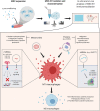Targeting the Immune System With Mesenchymal Stromal Cell-Derived Extracellular Vesicles: What Is the Cargo's Mechanism of Action?
- PMID: 31781552
- PMCID: PMC6856662
- DOI: 10.3389/fbioe.2019.00308
Targeting the Immune System With Mesenchymal Stromal Cell-Derived Extracellular Vesicles: What Is the Cargo's Mechanism of Action?
Abstract
The potent immunomodulatory activities displayed by mesenchymal stromal cells (MSCs) have motivated their application in hundreds of clinical trials to date. In some countries, they have subsequently been approved for the treatment of immune disorders such as Crohn's disease and graft-versus-host disease. Increasing evidence suggests that their main mechanism of action in vivo relies on paracrine signaling and extracellular vesicles. Mesenchymal stromal cell-derived extracellular vesicles (MSC-EVs) play a prominent role in intercellular communication by allowing the horizontal transfer of microRNAs, mRNAs, proteins, lipids and other bioactive molecules between MSCs and their targets. However, despite the considerable momentum gained by MSC-EV research, the precise mechanism by which MSC-EVs interact with the immune system is still debated. Available evidence is highly context-dependent and fragmentary, with a limited number of reports trying to link their efficacy to specific active components shuttled within them. In this concise review, currently available evidence on the molecular mechanisms underlying the effects of MSC-EV cargo on the immune system is analyzed. Studies that pinpoint specific MSC-EV-borne mediators of immunomodulation are highlighted, with a focus on the signaling events triggered by MSC-EVs in target immune cells. Reports that study the effects of preconditioning or "licensing" in MSC-EV-mediated immunomodulation are also presented. The need for further studies that dissect the mechanisms of MSC-EV cargo in the adaptive immune system is emphasized. Finally, the major challenges that need to be addressed to harness the full potential of these signaling vehicles are discussed, with the ultimate goal of effectively translating MSC-EV treatments into the clinic.
Keywords: cell therapy; extracellular vesicles; immune system; immunomodulation; mesenchymal stromal cells; paracrine signaling; regenerative medicine; stem cells.
Copyright © 2019 Martin-Rufino, Espinosa-Lara, Osugui and Sanchez-Guijo.
Figures

Similar articles
-
Mesenchymal Stromal Cell-Derived Extracellular Vesicles Attenuate Dendritic Cell Maturation and Function.Front Immunol. 2018 Nov 9;9:2538. doi: 10.3389/fimmu.2018.02538. eCollection 2018. Front Immunol. 2018. PMID: 30473695 Free PMC article.
-
Functional proteins of mesenchymal stem cell-derived extracellular vesicles.Stem Cell Res Ther. 2019 Nov 28;10(1):359. doi: 10.1186/s13287-019-1484-6. Stem Cell Res Ther. 2019. PMID: 31779700 Free PMC article. Review.
-
Human multipotent mesenchymal stromal cells cytokine priming promotes RAB27B-regulated secretion of small extracellular vesicles with immunomodulatory cargo.Stem Cell Res Ther. 2020 Dec 14;11(1):539. doi: 10.1186/s13287-020-02050-6. Stem Cell Res Ther. 2020. PMID: 33317598 Free PMC article.
-
Extracellular Vesicles Mediate Mesenchymal Stromal Cell-Dependent Regulation of B Cell PI3K-AKT Signaling Pathway and Actin Cytoskeleton.Front Immunol. 2019 Mar 12;10:446. doi: 10.3389/fimmu.2019.00446. eCollection 2019. Front Immunol. 2019. PMID: 30915084 Free PMC article.
-
Mesenchymal Stem/Stromal Cell-Derived Extracellular Vesicles and Their Potential as Novel Immunomodulatory Therapeutic Agents.Int J Mol Sci. 2017 Jul 6;18(7):1450. doi: 10.3390/ijms18071450. Int J Mol Sci. 2017. PMID: 28684664 Free PMC article. Review.
Cited by
-
Potential of Extracellular Vesicle-Associated TSG-6 from Adipose Mesenchymal Stromal Cells in Traumatic Brain Injury.Int J Mol Sci. 2020 Sep 15;21(18):6761. doi: 10.3390/ijms21186761. Int J Mol Sci. 2020. PMID: 32942629 Free PMC article. Review.
-
Nucleic acid drug vectors for diagnosis and treatment of brain diseases.Signal Transduct Target Ther. 2023 Jan 17;8(1):39. doi: 10.1038/s41392-022-01298-z. Signal Transduct Target Ther. 2023. PMID: 36650130 Free PMC article. Review.
-
Potential therapeutic application of mesenchymal stem cell-derived exosomes in SARS-CoV-2 pneumonia.Stem Cell Res Ther. 2020 Aug 14;11(1):356. doi: 10.1186/s13287-020-01866-6. Stem Cell Res Ther. 2020. PMID: 32795359 Free PMC article. Review.
-
Mesenchymal Stem Cell-Derived Extracellular Vesicles: Opportunities and Challenges for Clinical Translation.Front Bioeng Biotechnol. 2020 Sep 10;8:997. doi: 10.3389/fbioe.2020.00997. eCollection 2020. Front Bioeng Biotechnol. 2020. PMID: 33015001 Free PMC article. Review.
-
Regulation of Inflammatory Cytokine Storms by Mesenchymal Stem Cells.Front Immunol. 2021 Jul 29;12:726909. doi: 10.3389/fimmu.2021.726909. eCollection 2021. Front Immunol. 2021. PMID: 34394132 Free PMC article. Review.
References
Publication types
LinkOut - more resources
Full Text Sources

